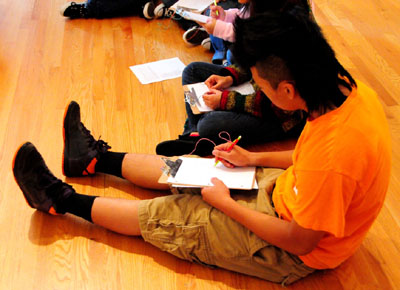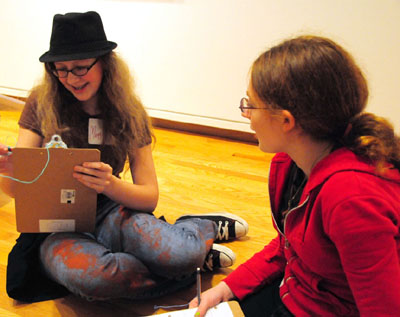Reflections on Picasso

Two Chief Sealth International High School students write in response to the Picasso: Masterpieces from the Musée National Picasso, Paris exhibition at the Seattle Art Museum, November 2010. Photo: Catherine Anstett.
Wallace Stevens published his poem Thirteen Ways of Looking at a Blackbird in 1917, around seven years after Pablo Picasso painted the cubist landscape Sacre-Coure. In the poem and the painting, these two artists explore one object (a blackbird and a Parisian church, respectively) through multiple perspectives. Jumping forward to November 2010, students from Chief Sealth International High School were introduced to both works during a visit to SAM Downtown and asked to add a layer of their own perspectives in a creative writing exercise led by teaching writers Cambray Provo and Jeanine Walker.
The students started looking at Sacre-Couer from across the gallery and walked slowly toward it as a group, saying all the different things the painting looked like to them as they moved closer. Once the students reached the painting, they compiled their observations and modeling after Thirteen Ways of Looking at a Blackbird, each student wrote a poem inspired by Picasso’s painting. The teaching artists encouraged students to “think about it from many different angles, things people wouldn’t normally think of when standing in front of it.” The students worked together for about twenty minutes, writing, revising, sharing with their peers, and the results were poems like Luke Garlock and Antonia Dorn’s below:
Three Ways of Looking at Sacre-Coer
By Luke Garlock
- An empty throne, no marks left upon its cushion.
The white dust has set, it is waiting for its king to return. - Triangles on the canvas form the pyramids of a once great civilization.
The sand dust the tops of these great stone structures. - Water as cold as the ice come in from rushes down the jagged rocks,
So sharp they could shatter glass.
Ways to Look at Broken Concrete
By Antonia Dorn
- Street after street,
Corner after corner,
These concrete runways are cracking. - Underneath that abandoned beer bottle lay
broken concrete as a shield
for the dirt and grass nearby - The pieces still contained in their hole and yet
you can still pick up your town in your fingers
this town being another home to many lying underneath
the same sun as the next street over
Luke and Antonia are two of the hundreds of students who visited the exhibition Picasso: Masterpieces from the Museé National Picasso, Paris as participants in a pilot partnership between the Seattle Art Museum and Seattle Arts & Lectures’ Writers in the Schools (WITS) Program. This fall, SAM & WITS invited students from five Seattle Public High Schools (Ingraham, Franklin, Chief Sealth, Ballard and Garfield) to visit the museum and write poetry inspired by Picasso: Masterpieces from the Museé Picasso, Paris. On five consecutive Wednesday mornings, SAM opened its doors early giving students a rare opportunity to explore the exhibition privately. Many of the students had never been to SAM before and few had seen work by Pablo Picasso in person. The WITS/SAM partnership culminated in a poetry reading at SAM’s Teen Night Out on December 10, 2010, where on-stage in the Brotman Forum participants read their Picasso inspired poetry to an appreciative audience of their peers.
As a Museum Educator at SAM, I was lucky enough to accompany the students on their early morning gallery adventures. This was one of many exciting partnerships born out of the Picasso exhibition and if I had to title my experience of working at SAM this fall, I might borrow from Wallace Stevens and choose “A Hundred Ways of Looking at Picasso.” I’ve now seen Picasso through the lens of art historians, educators, docents, REMIX visitors, teens, international travelers, Quileute tribal members, teaching artists, curators, students, parents, text panels, audio guides, educator resource materials and more. All these experiences have informed the way I view the man and his art, as well as the way I view the museum and our surrounding community. In particular, I appreciate the bright insights of the WITS student poets and I’m glad these teen perspectives got added to the mix of ideas surrounding this show. Picasso once stated that, “to make pictures was less important than to discover things all the time.” I certainly count these poems as discoveries and hope this work continues to expand.
Looking for more student poetry? Visit the SAM Educator facebook page for student poetry inspired by Picasso or email educatorprograms@seattleartmuseum.org for more information about SAM’s school partnerships.
– Regan Doody, Museum Educator for School and Educator Programs, Seattle Art Museum



